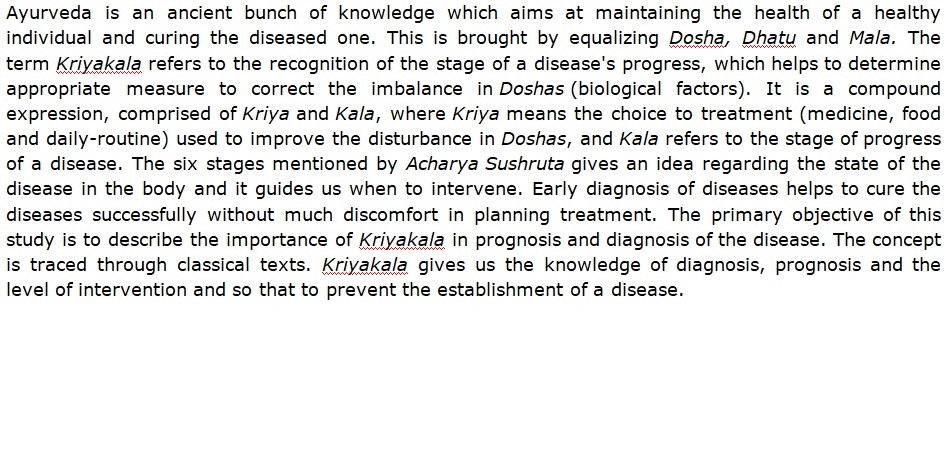Clinical significance of Kriyakala in Ayurveda
DOI:
https://doi.org/10.21760/jaims.v6i01.1191Keywords:
Kriyakala, Vyadhi, Dosha, Dushya, disease, etiological factorsAbstract
Ayurveda is an ancient bunch of knowledge which aims at maintaining the health of a healthy individual and curing the diseased one. This is brought by equalizing Dosha, Dhatu and Mala. The term Kriyakala refers to the recognition of the stage of a disease's progress, which helps to determine appropriate measure to correct the imbalance in Doshas (biological factors). It is a compound expression, comprised of Kriya and Kala, where Kriya means the choice to treatment (medicine, food and daily-routine) used to improve the disturbance in Doshas, and Kala refers to the stage of progress of a disease. The six stages mentioned by Acharya Sushruta gives an idea regarding the state of the disease in the body and it guides us when to intervene. Early diagnosis of diseases helps to cure the diseases successfully without much discomfort in planning treatment. The primary objective of this study is to describe the importance of Kriyakala in prognosis and diagnosis of the disease. The concept is traced through classical texts. Kriyakala gives us the knowledge of diagnosis, prognosis and the level of intervention and so that to prevent the establishment of a disease.
Downloads
References
Acharya JT. Sushrutha Samhita with Nibandhasangraha commentary of Dalhana.Reprint ed. Varanasi: Chaukamba Sanskrit Sansthan; 2010.p.111.
Acharya JT. Sushrutha Samhita with Nibandhasangraha commentary of Dalhana.Reprint ed. Varanasi: Chaukamba Sanskrit Sansthan; 2010.p. 103.
Gupta KA. Astanga Hridayam, Hindi Commentary Varanasi: Choukhamba Prakashan. 2007: 91. Hindi.
Paradara HSS. Ashtanga Hrudaya with Sarvangasundara commentory of Arunadatta and Ayurvedarasayana commentory of Hemadri.9thed. Varanasi:Chaukambha Orientalia;2011.p.13.
Paradara HSS. Ashtanga Hrudaya with Sarvangasundara commentory of Arunadatta and Ayurvedarasayana commentory of Hemadri. 9thed. Varanasi:Chaukambha Orientalia;2011.p.195.
Paradara HSS. Ashtanga Hrudaya with Sarvangasundara commentory of Arunadatta and Ayurvedarasayana commentory of Hemadri.9th ed. Varanasi:Chaukambha Orientalia;2011.p.196.
Acharya JT. Charaka Samhita with Ayurveda Dipika commentary of Chakrapani Datta. Reprint ed. Varanasi (India): Chaukambha Orientalia; 2011 .
Acharya JT. Sushrutha Samhita with Nibandhasangraha commentary of Dalhana, Reprint ed. Varanasi: Chaukamba Sanskrit Sansthan;2010. p.105.
Shirke PR, Deshmukhe PN, Patil RB, Kirte MC, Sawant DP. Study of Dhatupradoshaja Vikar w.s.r.t. Raktadhatupradoshaja Vikara: a literery review. Int J Ayu Alt Med. 2016; 4:p. 116–122.
Kumar B, Paliwal M. Concept of Shatkriyakala as mentioned in Sushruta Samhita. J Adv Res Ayur Yoga Unani Sidd Homeo. 2014; 1: p.10–12.
Acharya JT. Sushrutha Samhita with Nibandhasangraha commentary of Dalhana, Reprint ed. Varanasi:Chaukamba Sanskrit Sansthan; 2010.p.105.
Bhosgikar A. A review on Shatkriyakala. Int Ayurved Med J. 2014; 2: p. 318–324.
Acharya JT. Sushrutha Samhita with Nibandhasangraha commentary of Dalhana. Reprint ed. Varanasi: Chaukamba Sanskrit Sansthan;2010.p.103-104.















